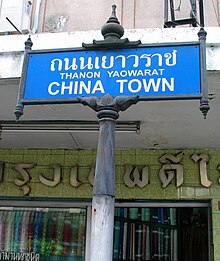Thanon Yaowarat
The Thanon Yaowarat (Thai: ถนน เยาวราช - Engl .: Yaowarat Road , German roughly: "Road of the Young Crown Prince") is a street in the Samphanthawong district of Bangkok , the capital of Thailand .
geography
The Thanon Yaowarat is about 1.5 kilometers long. It begins at Odeon Circle and ends at Phanuphan Bridge on the outskirts of Phahurat , the market district of the Indian population.
history
The Samphanthawong area has been inhabited by Chinese since the founding of Bangkok. Before Bangkok became the capital of the Siamese Empire in 1782 (during the so-called Rattanakosin period), a Chinese community lived on the grounds of what is now the Grand Palace . They were kindly "asked" by King Phra Phutthayotfa Chulalok (Rama I) to relocate their businesses to the "gardens", a then unpopulated area in front of the city that is now known as Sampheng . The narrow Sampheng-Alley ( สำ เพ็ง ), now called Thanon Wanit ( ถนน วานิช 1 ), was for a long time the main thoroughfare of the Chinese quarter, "with a maze of narrow streets and nested buildings, as was common in the Middle Kingdom". She was at that time also a notorious red-light district , where brothel -ranked brothel. The Chinese prostitutes allegedly all had to use the surname Kim. Today it is mainly cheap household goods, plastic toys, fabrics and textiles and devotional items for the locals that are sold here. The alley is so narrow that the goods have to be dragged along on your back. Vehicles cannot get in here.
In 1863, at the urging of many Bangkok foreigners, the paved New Road ( Thanon Charoen Krung ) was added. After a devastating fire in 1891, King Chulalongkorn (Rama V) allowed the construction of a third thoroughfare, Yaowarat Road , the course of which he personally marked on a map. Because of the dense development, the construction of the street lasted until 1899. Due to a misunderstanding between the Chinese and the authorities, the street now winds through the district like a dragon , a Chinese symbol that is attributed to the prosperity of the area.
During the reign of King Vajiravudh (Rama VI) , the Yaowarat area became the entertainment hub of Bangkok. The first six- to nine-story “skyscrapers” with cinemas, hotels, brothels and opium dens - which were not yet illegal at the time - were built. It was en vogue to go out to eat on the Yaowarat. The seven-story “China Town Hotel” and the nine-story “New Hotel” are still standing today.
A tram line ran through Thanon Yaowarat until the 1960s. The attentive visitor can still find the red triangles on the roadside in some places, which represented the tram stops.
Today Yaowarat is not only a thriving business area, where most of Bangkok's gold shops can be found, for example, but also a center for gourmets, as numerous restaurants offer Chinese and local specialties. Countless food stalls are only opened after sunset on the roadside and in the winding back streets of the Yaowarat.
Attractions
- Wat Traimit near Odeon Circle, the start of Thanon Yaowarat.
- Wat Chai Chana Songkhram
- Talat Kao (Old Market) - the over 100 year old market on Issaranuphap Lane is known for its fresh and canned food, which is still bought daily by the chefs of the specialty restaurants. Directly opposite is the Talat Mai (Neuer Markt) , which, however, has a similar offer.
- Nakhon Kasem Center - a small area between Thanon Yaowarat and Thanon Charoen Krung, in which things that had "fallen from the truck" were previously sold - hence the name "thieves' market". Today, in addition to antique shops and shops for musical instruments, there are also well-known bookshops and shops for agricultural machinery.
Impressions from Thanon Yaowarat
literature
- Steve Van Beek: Bangkok then and now . AB Publications, Nonthaburi 2001, ISBN 974-87616-2-2 (English original edition from 1999: ISBN 974-87063-9-7 )
- Khunying Nathanon Thavisin (Ed.): Yaowarat, a Handbook with Maps for "Bangkok on Foot" . Bangkok Metropolitan Administration, Tourism Division, Bangkok 2005
- Edward Van Roy: Sampheng - Bangkok's Chinatown Inside Out . Institute of Asian Studies, Chulalongkorn University, Bangkok 2007, ISBN 974-9990-33-1
Individual evidence
- ↑ http://www.thai-language.com/id/213974
- ↑ Van Beek: Bangkok Then and Now 1999
- ↑ http://www.chinatownhotel.co.th/
- ↑ Map of the tram network of Bangkok projected onto the current city map from GoogleMaps
- ↑ Collection of articles at 2bangkok.com about the tram in Bangkok ( Memento of the original from March 8, 2009 in the Internet Archive ) Info: The archive link was automatically inserted and not yet checked. Please check the original and archive link according to the instructions and then remove this notice. (in English)
Web links
Coordinates: 13 ° 44 ′ 19.7 " N , 100 ° 30 ′ 43.8" E






